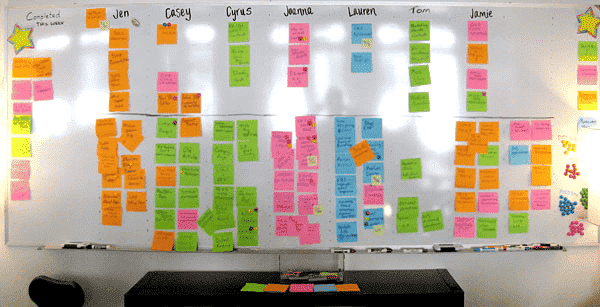You’ve come to the perfect spot if you feel like you have much too much to do in your marketing profession and not enough time to accomplish it.
You’d want to become organized, but you can’t take a break from your everyday responsibilities long enough to devise a system that works for you and your team.
In this article, we’ll show you how to build up your digital marketing planner. It will assist you in prioritizing the correct marketing activities, developing a repeatable process — so you never forget a job or miss a deadline — and publishing content that benefits your audience.
Do you want to improve your marketing outcomes while reducing your stress? This is the guide for you.
What is a Marketing Planner?
A marketing planner, also known as a strategic marketing planner, is a marketing tool that helps you plan and carry out your marketing operations.
It’s a platform that consolidates all of your marketing duties and deadlines into a single location. It serves as a single source of truth for marketing teams of various sizes, including one-person operations. Instead of having to resort to different notes, papers, and emails, you can depend on one unified hub to know precisely what it takes to meet your marketing objectives.
A marketing planner may assist you in the following ways:
- All marketing initiatives and duties should be coordinated. There will be no more uncertainty, jobs falling through the gaps, or concentrating on low-priority initiatives.
- More work may be completed in less time and with less stress. Every member of the team understands what to work on next, which eliminates friction and enhances attention, deep work, and innovation.
- Inform higher-ups about your progress. Because you can see what you’re working on and what occurs next at a glance, you can simply provide status updates to your managers and executives.
Types Marketing Planners
Here are six distinct types of marketing planners, ranging from physical goods to software solutions.
#1. Paper Calendars
If you currently use printed paper calendars in your daily life, a marketing version of such a planner may be of interest to you.
A monthly, quarterly, or annual summary may be included in your printed calendar. You may then use it to plan and map out:
- Your publication dates for blog posts, emails, videos, and any other kind of material you employ.
- Product launch dates are important.
- Seasons/holidays relevant to your sector (for example, Black Friday, Mother’s Day, and social media holidays such as International Coffee Day or National Dentist’s Day).
This will provide you with a fast overview of your marketing plan. Keep in mind that any changes to publication dates may cause your other plans on the same calendar to be thrown off, and you may need to correct them one by one.
If you make a modification to one plan, be sure it does not affect other plans.
#2. Whiteboards
Whiteboard marketing planner is ideal for organizations who think visually and like to keep their processes nimble.

To get the most out of your whiteboard marketing planner, use whiteboard markers, sticky notes, or both. There are a few different methods to structure:
- Content types include blog entries, emails, videos, whitepapers, and so on.
- Members of the team
- Team duties include strategist, writer, designer, editor, and so on.
- Stages of the process include: concept backlog, writing, designing, editing, final approval, and publication.
- Marketing Personas.
Whiteboards are excellent for both a large picture perspective and a day-to-day plan of action. They’re simple to update, but they have a drawback if your crew isn’t constantly working from the office.
In such a situation, you’ll need an online planner that doesn’t need everyone to be in the same room at the same time.
#2. Physical Notebook-Style Planners
A notebook-style marketing planner is a next choice on the physical side of planner alternatives.
This is a portable, pocket-sized version of a printed paper planner. They’re popular among single bloggers and businesses, and there are even content-specific planners available.
These planners would not function as a team since they do not allow for cooperation and idea exchange. A notebook planner version, like everything else done on paper, takes a little longer to update if anything changes in your campaigns, deadlines, or launches.
Notebook-style planners do not allow for cooperation; keep this in mind while deciding on a marketing planning strategy.
#3. Kanban Boards
A marketing kanban board enables you to move projects through process phases – from left to right from starting to conclusion.
A kanban board is made up of columns that reflect phases in your marketing process, and the cards in these columns represent projects. In this situation, you’d have:
- Marketing process phases are shown as columns: write, design, edit, review, and publish.
- The marketing project in the form of cards: blog article on [subject 1], email campaign promoting that blog post, YouTube video interview with [expert]
Marketing planners as a kanban board are an ideal method to empower teams of all sizes, whether in-house or remote, to constantly know what’s on their plate and what to prioritize to optimize the outcomes of their marketing initiatives.
#4. Spreadsheet-based Calendars
You may utilize a spreadsheet-based marketing calendar if you enjoy the notion of a digital marketing planner but don’t want to be constrained by kanban boards.
Spreadsheets provide you with the benefit of versatility. There are several ways to arrange it.
- As a calendar, with columns representing the days of the week and rows representing various weeks.
- As a list of issues with priority levels, individuals in authority, current status, and other information.
- Also as a collection of monthly themes — each month has its own tab.
Spreadsheet-based marketing plans are wonderful since they can reside in the cloud and be available to your whole team due to services like Office 365 and Google Drive.
#5. Marketing Calendar Software
Finally, there’s marketing calendar software with capabilities targeted to your and your marketing team’s demands.
This is the ultimate hub for all of your blogging and social media activities. It’s your go-to, daily center for everything your marketing team does. You’ll be able to do the following if you use a Marketing Calendar:
- Change between the calendar and kanban views.
- With a simple drag-and-drop, you may move dates, campaigns, and tasks.
- On a timeline, you may get a large picture summary of content types, social media campaigns, particular assignments, and more.
You will reclaim complete control over your marketing activity if you use marketing planner software. Everything that helps your business development will be kept in one place, making it simple to access, modify, and schedule your content.
How to Use a Marketing Planner: 5 Easy Steps
Now that you’ve determined which form of marketing planner is ideal for you, here’s how to get started and make the most of it.
#1. Begin with a Basic Content Strategy
Your marketing planner can help you become more focused and organized, but only if you utilize it strategically.
In other words, you must know what you want to accomplish with your marketing activities. This is the only method to view results.
Here’s a straightforward way to content marketing strategy.
1. Determine your company’s goals.
Do you want to lower churn? Increase your revenue? Increase customer lifetime value? Is there anything else? This will assist you in mapping your content to the appropriate section of the funnel.
2. Determine your target audience.
What are their difficulties? Demographics? Where are the snags? Where are they looking for answers, and what format are they looking for? How can you assist?
3. Determine the heart of your material.
It’s a mismatch between what your audience cares about and what your company offers. Define the subjects and categories that are the most closely connected to your product.
4. Choose your content types and channels carefully.
Take into account blog posts, email newsletters, videos, social media content, print materials, ebooks and whitepapers, case studies, and graphic content.
5. Create a publication schedule that you can stick to.
Choose something you can sustain in the long term – one blog post each week is a good place to start, and you can always work your way up to more later. Create a publication schedule that you can stick to for all of the formats you’ve chosen.
6. Determine who is engaged in the creation of your material.
Are you a one-man marketing team? Do you have editors, designers, or social media writers on your team? Make a list of everyone who will be on your marketing calendar.
#2. Develop Marketing Projects in accordance with Your Strategy
You have a goal, a target audience, a core of content, and formats. It’s time to plan to brainstorm and planning your marketing efforts using them.
- In 10 minutes, jot down as many ideas as you can. Don’t hold back; just jot down anything that comes to mind.
- In 10 minutes, rate your ideas with a 1, 2, or 3. 1 denotes mediocrity, 2 denotes averagecy, and 3 denotes exceptionalcy.
- Take 10 minutes to prioritize and consider all of your threes. Consider possible headlines, perspectives, and tools to help these themes stand out.
When you’ve come up with a list of fantastic content ideas, consider the forms and channels that will best suit these themes. Here are some questions to think about:
- Is it better to cover this concept in paper, video, or audio?
- Is it possible to make this subject into a series with many pieces of content?
- Can I interview experts or provide any outside resources to make this issue more valuable to my target audience?
- Is this issue more significant at particular times of the year, and if so, should it be prioritized?
- Is this subject relevant to the top, medium, or bottom of our marketing funnel?
Make a note of the ideal formats and channels for each of the content themes on your list.
Remember that you may reuse material that you post on one channel across several channels and in various forms. Prioritize the most important ones first, and then consider repurposing.
Repurpose the material you post on one channel so that it may be published on other channels as well!
#3. Make a checklist for each marketing project.
Don’t want to overlook a task for one of your new marketing initiatives? If so, you’ll like checklists.
Marketing chores are critical for taking your content ideas from concept to reality. These are all of the individual steps required to publish a blog post, send an email newsletter, or publish an ebook, for example.
This is an important aspect of your marketing planner; marketers who plan initiatives and activities ahead of time are 356 percent more likely to declare success.
By converting your marketing chores into checklists, you may establish your approach once and simply follow it the next time you work on that particular content type. Nothing will ever fall through the gaps… ever.
Here is how you may create your own marketing project checklists:
- Identify all of the different sorts of projects you have. Blog postings, YouTube videos, email newsletters, and social campaigns are all examples.
- Make a list of all the current stages for each project category. A blog article, for example, will include keyword research, an outline, writing, editing and proofreading, design, CMS formatting, and scheduling.
- Clean up your project-specific step list. Is there anything that might be skipped? Can you combine some of them?
- Decide who will be in charge of which steps. Consider your SEO strategist, content strategist, writer, designer, editor, and other jobs.
- Tasks should provide time estimates. Is it true that a work takes 30 minutes? What, an hour? What, three hours? More? This will assist you and your team in scheduling these chores throughout the workday.
- Establish task deadlines. How far in advance of the publication date must each assignment be completed?
Read Also: Work Schedule: Steps to Schedule Employees Effectively
Repeat this approach for each kind of material you plan to develop.
You should end up with checklists that look like this:
- Task 1 (30 minutes), [person 1] 10 days before publication
- Task 2 (one hour), [person 2], seven days before publication
- So, task 3 (two hours), [person 1], seven days before publication
- … and so on.
#4. Collaborate with your marketing planner to establish deadlines.
You may now begin to flesh out your marketing planner.
Take the marketing campaigns you’ve planned and designate publication dates for each on the planner based on the publishing cadence you established.
Then, using your checklists, begin adding all marketing tasks for those initiatives to the calendar as well. If you have a marketing team, these duties and deadlines should be made public and accessible to all team members.
A team-wide marketing calendar will assist you in the following ways:
- Recognize each team member’s bandwidth at each given time.
- Make certain that no one is overburdened with work.
- By reassigning jobs, you may minimize delays and missed deadlines by identifying possible bottlenecks.
#5. Begin Shipping More Projects and Get Rid of Stress
As you begin to use your marketing planner, you will ship more marketing initiatives than ever before, with less stress and on schedule – every time.
To ensure that your marketing planner is constantly assisting you in meeting your marketing objectives, be sure to modify it regularly and identify any deviations so you can respond quickly:
- Are some chores taking you less time or more time than you expected? Make a note of it in your to-do lists.
- Are certain formats or channels more effective than others? Adjust your strategy and build on what works.
- Is your bandwidth increasing or decreasing? Make changes to your publication cadence.
As with everything in marketing, evaluate your team’s influence and outcomes so that you may change your marketing plan in the future.
What is a Digital Marketing Planner?
A digital marketing planner is a document in which you sketch out your digital marketing objectives as well as the steps you’ll take to attain those goals.
It may comprise, among other things, corporate objectives, digital strategies to achieve those objectives, competitive landscape analyses, timetables, budgets, digital channels, and more.
Consider a digital marketing planner to be a type of road map. You know where you want to go, and the plan lays out a clear path for you to go.
Your digital marketing efforts will be wasteful and unproductive unless you have a well-defined planner in place. You’ll most likely wind up squandering money and failing to have the desired effect.
How to Make a Digital Marketing Planner
Let’s now go through the different digital marketing planner components, as well as the precise stages to take as you construct your strategy.
#1. Establish your digital marketing and commercial objectives.
Clear, quantifiable, and realistic digital marketing planner goals assist you in defining precisely what you want to accomplish and measure. Be as specific as possible when defining these objectives. Include precise metrics and dates that may be used to track your development.
Avoid objectives such as increasing lead generation, increasing conversion rates, or improving digital customer experience. Those are a little too hazy. You can’t quantify your progress, and it’s unclear what actions you should take to get there.
A much more attainable aim would be to quadruple organic search traffic in the following 12 months. This gives you a timeframe, a structure for establishing milestone targets, and precise steps to follow (optimize your site, create amazing content, and conduct strategic outreach for SEO, etc.).
SMART Goals (Specific, Measurable, Achievable, Relevant, Time-bound) provide clarity on the activities required to accomplish those things.
#2. Identify audience segments and buyer profiles.
To be effective with any digital marketing effort, you must first understand who you are attempting to reach. Building buyer personas for each sector of your audience may offer you insights into what sorts of marketing will be most successful.
- Assume you provide IT services. Small firms with less than $500,000 in sales may be among your target audience. You might also target major organizations with strong IT requirements. Your buyer personas and marketing techniques will be significantly different for each of these categories. Messaging that appeals to a small company owner is unlikely to appeal to the head of a big IT department, and vice versa.
- Begin by determining the various categories of your target audience. Begin by creating personas for your ideal consumer inside each group. Here are 9 terrific persona samples to get you started.
Your buyer persona information will differ based on whether you are B2B or B2C, as well as the cost of your product/service. You may wish to include the following demographic and extra information:
- Age group
- Income
- Occupational title
- Location
- Priorities
- Goals
- Challenges
- Interests
- Platforms for social media
- Industry
- Points of contention
- Desired products/features
- Invent new customer personas.
The purpose of designing personas is to go into the heads of your target consumers and view things through their eyes. When you learn what is most important to them, you can create a digital marketing plan that addresses both their deep wants and major issues.
#3. Carry out a competition study to assess market share.
If you want your marketing efforts to be successful, you must first understand who your competitors are. A competitive study enables you to identify your rivals, evaluate your market share, and learn about their marketing strategy.
Consider the following factors while doing a competitive analysis:
- Which demographics are they aiming for?
- What are your rivals’ digital marketing channels?
- What is their seeming difference?
- Where are they most powerful?
- What percentage of their traffic is earned, owned, or paid?
- What is their market positioning?
- Where are they most vulnerable?
- What kind of message and language do they employ?
- What is the tone and personality of their brand?
A comprehensive competitive landscape study will provide you with insights into how you can utilize internet marketing to outperform your competition. For example, you may understand that your rivals’ positioning and difference are widely understood, therefore you will profit from crystallizing your own in comparison. Alternatively, you may learn that they excel at social media marketing yet fall short when it comes to search engine optimization (SEO) effectiveness.
#4. Perform a SWOT analysis
A competitive landscape study is the inverse of a SWOT (strengths, weaknesses, opportunities, and threats) analysis. It gives you a framework for examining your company within the context of your market. It lets you analyze what works and what doesn’t, discover possible organic development prospects, and prepare for external dangers.
Begin by assessing your company’s strengths. What are your key competitive advantages? What are you especially good at? So, what one-of-a-kind resources do you have at your disposal?
Next, consider your flaws. What aspects of your company aren’t doing well? What factors are preventing you from making sales? Where do you lag behind your competitors?
The third stage is to carefully examine the prospects that are accessible to your firm. Are there any market trends that you can capitalize on? Can you make use of new technologies that your rivals cannot? Is there a demographic in your audience that is underserved?
Finally, make a list of any possible dangers to your company. Is it possible for a rival to take market share? Is there anything impeding company growth? Are there any financial concerns on the horizon?
The information gleaned from your SWOT analysis will aid in the creation of your digital marketing plan. Your plan should capitalize on your strengths, reduce your weaknesses, seize opportunities, and prevent potential risks as early as possible. All in the guise of assisting you in increasing sales.
#5. Determine the budget for your digital marketing planner.
The next stage in developing the finest digital marketing planner for your company is to determine your budget. The budget will specify how much money you have to spend on digital marketing activities, as well as direct you to certain channels, methods, and approaches.
The amount you set aside for a digital marketing planner will depend on a variety of things, including:
- Revenue
- Place in the industry
- Previous outcomes
- Goals
- Location
- A strategy’s, tactic’s, or campaign’s profitability
How much money will you devote to increasing brand awareness? What about special marketing and promotions? Will you set aside a portion of your digital marketing budget for customer retention? Do you know how much money you should spend on SEO?
It is critical to plan your budget ahead of time. Maintain flexibility, however, to capitalize on opportunities for increased SEO ROI. If you notice that a particular campaign isn’t generating a positive ROI, you might be better off eliminating it. Similarly, if you see that a certain campaign (or channel) is yielding outsized results, consider adjusting the budget and allocating more funds to what’s doing effectively. If you have a certain return-on-investment in mind that is very lucrative, keep raising the budget as long as your acquisition expenses remain below the objective.
As a result, your budget may serve as a dynamic, ever-changing support mechanism for your digital marketing campaigns.
#6. Establish your digital outlets
Before you can create a content strategy, you must first identify the major digital platforms you will use. Your channel selection should take into consideration your audience, objectives, and budget.
Assume you aim to increase targeted visitors to your website by 30%. One method is to use PPC advertisements, which may provide you with an instant boost. However, Google Adwords might be costly.
Turn to more cost-effective methods, such as SEO and content marketing, to boost ROI. These channels take longer to yield results, but they also have a far lower acquisition cost, providing you with more bang for your dollars. Furthermore, the effects of SEO and content marketing compound over time, laying the groundwork for long-term, sustainable success.
Consider where your target audience spends the majority of their time when developing your digital platforms. If you work in a B2B business, you may want to concentrate on platforms such as LinkedIn or webinars. If your target demographic is younger, you may want to investigate Instagram influencer marketing. Concentrate on how you can provide value to your audience using the media they prefer.
Also, don’t assume that your audience is uninterested in fantastic material. Some of the top content marketing examples come from a diverse spectrum of businesses with very varied target audiences.
#7. Create digital marketing strategy and approaches.
Following the definition of your channels, you must establish the digital marketing methods and strategies that will be used inside those channels.
For example, if you want to concentrate on search engine optimization, you must first decide which keywords to target and how to target them. You may construct a complete content center, online courses, SEO subject clusters, or a collection of online tools. You might also choose to give more extensive, better how-to knowledge, analysis on forthcoming trends, or content showcasing celebrities.
Look for methods to separate yourself from the competition as you plan your digital marketing plans and approaches. You will struggle to distinguish apart if you do what everyone else is doing.
- Dollar Shave Club drew notice by being humorous and irreverent in an otherwise dull sector.
- Tableau provided a free online tool and received backlinks from over 56,000 domains.
- LEGO established an online, interactive community that receives over 300,000 organic visitors every month.
The more saturated the market, the more difficult it will be to catch attention and achieve genuine optimization throughout your digital marketing portfolio. Be loyal to your brand in all you do while building your digital marketing plans and approaches.
#8. Make a marketing calendar.
A marketing calendar helps you to plan out when your digital marketing campaigns and activities will be implemented. It also generates responsibility, ensuring that you meet deadlines and carry out the plan efficiently throughout the year. A calendar also ensures that you contact each of your audience groups regularly throughout the year.
Make a plan for the next 12 months and divide your calendar into each month of the year. This will provide you with an overarching structure as well as enough time to plan and execute each delivery. As an example:
You’ll be releasing a training webinar in January. Before you can release it, you must first prepare a presentation deck, a landing website, and social media graphics, among other things.
Throughout January and February, you will advertise the training webinar using various means such as social media, email, video, and public relations.
You’re planning to start a blog in March that will be updated weekly. To do this, you must decide on subjects, assign them to writers, collaborate with a designer, develop a blog schedule, arrange films to be included, and so on.
When making your calendar, be practical. Allow yourself enough time to do everything in a timely and quality way, and make certain that each delivery is properly allocated to certain people.
CoSchedule, Contently, and Trello are three popular marketing scheduling platforms.
#9. Track the outcomes and key performance indicators (KPIs) of your digital marketing planneer.
The last stage in developing a digital marketing strategy and plan is to assess your outcomes by defining metrics and key performance indicators (KPIs). You must evaluate the results of your marketing activities to both the baseline and the original objectives. If the findings are disappointing, alter and optimize before measuring again.
Make a point of measuring each channel so that you, as a marketer, can understand what is performing best for your brand and what may need to be reduced.
Excellent Digital Marketing Planner foster Integration.
The process of creating a digital marketing planner promotes marketing integration, which creates a higher business impact. Customers will not be able to ignore your brand if you continually bombard them with messages, offers, and calls to action. As a consequence of effectively and wisely reusing and atomizing your marketing materials, you will accomplish more with less.
Whether your firm is a well-established e-commerce brand or a brick-and-mortar behemoth, you must have a digital marketing plan. It takes time, effort, and coordination, but it is well worth the effort. Your marketing will be much more effective, and you will generate far better marketing outcomes for your company.
Marketing Planner Career
*A Marketing Planner’s profession comes within the larger occupational area of Marketing Managers. This page’s material will generally apply to all occupations in this category, although it may not explicitly apply to this job title.
Marketing Planner Job Description:
Plan, direct, or coordinate marketing plans and activities, such as assessing demand for a firm’s and its rivals’ goods and services and identifying new consumers. Create price plans to increase the firm’s earnings or market share while keeping consumers pleased. Monitor trends that suggest the demand for new goods and services or supervise product development.
Use Your Marketing Planner to Its Full Potential
Your marketing planner will help you become more efficient, organized, and on track with your marketing and company objectives. Your target audience will be delighted, and they will become dedicated readers and consumers.
With these five easy actions, your marketing team will be able to do more and eliminate missed deadlines for good.
What role does data play in the work of a marketing planner?
Data is a crucial component in the work of a marketing planner. Marketing planners need to be able to collect, analyze and interpret data from a variety of sources to inform their marketing plans and decisions. This can include data on consumer behavior, market trends, competitor analysis, and sales performance. By using data, marketing planners can make informed decisions, set achievable goals and measure the success of their marketing efforts.
What tools and technology do marketing planners use to complete their work?
Marketing planners use a range of tools and technology to complete their work, including project management software, customer relationship management (CRM) systems, data analytics tools, and marketing automation software. They may also use tools such as spreadsheets, presentation software and graphic design tools to create visual aids and presentations.
How do marketing planners prioritize tasks and allocate resources?
Marketing planners prioritize tasks and allocate resources by setting specific goals and objectives for their marketing plan. They consider factors such as budget, timeline, target audience and resources available when making decisions about what tasks to prioritize and how to allocate resources. Marketing planners also regularly review and adjust their plans based on data and results to ensure they are on track to meet their goals.
What are the most important metrics for measuring the success of a marketing plan?
The most important metrics for measuring the success of a marketing plan can vary depending on the specific goals and objectives of the plan. Some common metrics include website traffic, lead generation, conversion rates, customer engagement and brand awareness. Marketing planners use these metrics to determine whether their marketing efforts are effective and make changes as needed to improve their results.
Marketing Planner FAQs
Who is marketing planner?
The marketing planner assists in the brainstorming of marketing campaigns and then puts those campaigns through test scenarios to find any issue areas or special advantages the campaign possesses. They then emphasize such characteristics and present their plans to marketing managers.
Is marketing manager a stressful job?
According to research conducted by Workfront (2), a producer of project management software, one in every four industry professionals reported experiencing “severe stress” daily. The remainder of the group claimed that there was at least some tension in the workplace.
What personality do you need for marketing?
Although the particular skill requirements differ from job to job, the attributes required for success in marketing are constant throughout the professional range. Good marketers are outstanding communicators, team players, and project managers, with strong analytic and creative abilities.






